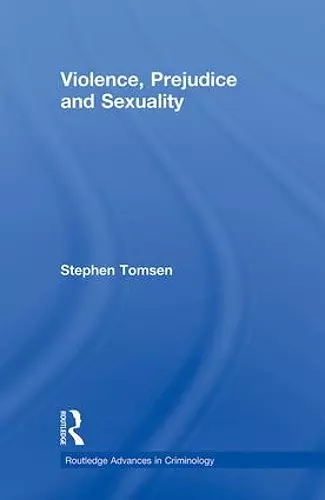Violence, Prejudice and Sexuality
Format:Paperback
Publisher:Taylor & Francis Ltd
Published:30th Sep '10
Currently unavailable, and unfortunately no date known when it will be back
This paperback is available in another edition too:
- Hardback£150.00(9780415956550)

The binary model of sexuality can be devastating and even fatal for people left outside the category of heterosexuality. Essentialist categories of sexuality and gender are often enforced by harassment and violence, as is clear in the case of violence directed against sexual minorities such as homosexual men. This book investigates why men launch assaults on sexual minorities, why these attacks are so vicious and frequently irrational, the identities of perpetrators and their victims, and why such violence seems to have some acceptance in fields such as law, psychiatry, the media and popular opinion.
Tomsen discusses the theoretical and research literatures on models of understanding human sexuality and gender and the nature of hate violence and prejudice in contemporary societies, and also provides an analysis from his own original research to draw out the contradictory nature of both sexual identity and violence and the significance of viewing both fields as linked domains. This text makes an important contribution to current and future discussions of the nature of social prejudice and its ties to legal rulings, collective beliefs and mainstream culture.
'Tomsen’s work therefore offers a more sophisticated, complex conceptualisation of violence against gay, lesbian, bisexual, and transgender people as based in corporeal masculinities and sexual, bodily boundaries. The book highlights well the discrepancies and discomfort with relying on homophobia as a catch-all explanation for anti-homosexual sentiment and violence. Most importantly, Tomsen does this while maintaining that injustice continues to prevail, particularly in our legal system. His analysis successfully demonstrates that, regardless of context, homosexual panic defence is an archaic historical relic that serves no purpose other than to continue to excuse the vicious murder of gay men on the basis of their sexual orientation. In addition, the book sends a clear message that violence against gay, lesbian, bisexual, transgender people persists in many forms and is inexcusable in any context, but responses to this violence are better informed by a more nuanced understanding than to slip into essentialist, pathologising arguments about homophobia. Indeed, Tomsen correctly notes that even criminologists need to explore further the role of masculinity in anti-homosexual violence and sentiment, and certainly governments and legal systems continue to almost completely overlook this as an important motivating factor when adjudicating crimes of this nature.
By drawing together interdisciplinary research and writing, Tomsen’s book is an impressive contextualisation of research on these issues, and this makes it a ‘must-read’ for academics, researchers, and policy workers in this area. Although the focus of the research in this work is Australian, it engages with issues significant in a global context and is certainly relevant to international researchers in this area. The key strength of this book is that it leaves the reader with no doubt that, as long as we persist with essentialist understandings of violence, our legal system will continue to produce unjust legal outcomes.'-Dr Angela Dwyer, Queensland University of Technology, in Current Issues in Criminal Justice, vol 23 no 3
ISBN: 9780415886550
Dimensions: unknown
Weight: 380g
188 pages